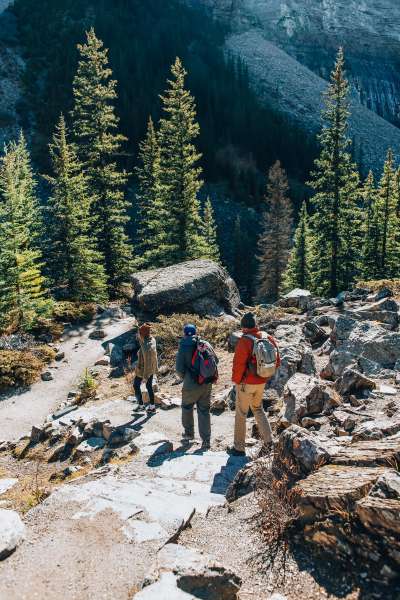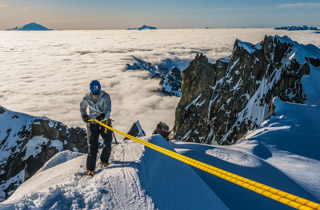Flat-land Mountaineering Training
Flat-land Mountaineering Training
Mountaineering Needs
If, like so many aspiring mountaineers, you live in relatively flat terrain at great distances from any significant elevation gain (or cannot regularly get to the mountains for conditioners), but you still wish to get into mountaineering condition for a course, trek, or trip, how do you go about getting ready?
The first step to getting into the right physical condition is having a firm grasp of what your adventure will involve in terms of travel distance and elevation gain (total and per day), pack weight for the approach and summit days, end altitude (i.e. will your trip take you above 10,000 feet? If so, include intervals training) as well as terrain you are likely to encounter and tasks you will accomplish on the journey (any technical component involving ice or rock, building a shelter, ice axe arrest practice, and so forth). To evaluate your sport’s needs look at The Outdoor Athlete, which evaluates 16 different sports.


Uphill Propulsion Muscles in Cardiovascular Training
The most important groups of muscles to train for any mountaineering approach are the posterior, or backside, muscles including the hamstrings, gluteals, calves, lower back, and hips. To do so, simulate uphill climbing as often as possible in your training. If you live in Florida where the highest point is barely above sea level, you will have to get creative: add StairMaster or revolving step mill training, walking on a high ramp treadmill, high ramp elliptical training, stairs, hilly sand dune walking, and any varied terrain you can find. Add step aerobics workouts (with an 8- or 10-inch high platform) for variety and muscle balance. Just be sure whatever level choreography you choose is appropriate to your familiarity with step training so you do not inadvertently trip over the step and injure yourself!
Please do not get in the habit of always or only doing machine training, as tempting as it is for getting the uphill training. Even if you live where it is relatively flat, walking on the beach (in shoes or barefoot), over rooted dirt trails, or on grass or gravel paths, will all provide more training stimulus for the ankles, calves, feet, and ultimately the whole body than always training on a machine. Include pack-weighted cardiovascular machines for spice or in inclement weather to supplement getting outside. The key is to include training sessions with both.
Downhill Hiking Muscles
If there is any area where flatland training lags behind mountain training, it is in getting the quadriceps used to repetitive downhill walking. There simply is no equal substitute for walking downhill or descending stairs since nearly every cardiovascular machine involves such a strong uphill component. However, there ARE things you can do to build adequate muscle strength to survive the downhill portion of your trip.
- Include backward walking (especially on any sort of slope) to target the quadriceps
- If you have short hills, local stadiums, or stairs anywhere nearby, do repeats or laps on them at least once a week. Even if your hill is 200’ high, 5 laps will give you 1000’ of elevation gain and great training for the quadriceps.
- Include quadriceps-building strength exercises such as the VMO reverse step-up that specifically target the downhill-walking muscles in the quadriceps (for a video and description see Knee Strength)
- Include a wide range of other leg strengthening exercises such as those demonstrated in the Train to Climb Mt. Rainier or Any High Peak DVD for more about this product) to ensure muscle balance and reduce the chance of strain, soreness, or injury on your adventure.
Pack-carrying Muscles
In addition to training the legs, also remember that the muscles of the upper back and core (abdominals, obliques, lower back) are strongly involved in pack carrying as well. Including pull-ups, pushups, triceps dips, shrugs, and standing core exercises will pay off handsomely in helping the upper body carry the pack weight. During your cardiovascular workouts, be sure at least one mid-week workout involves carrying a weighted backpack. This can be a shorter workout than your weekend endurance workouts. In fact, even if you CAN do mountain training, it behooves you to have a mid-week pack workout on stairs, hills, or uphill cardiovascular machinery. I include elliptical pack training for several months leading up to any trip.
Back-to-Back training
In addition to suitable cardiovascular exercise and strength training, you need to include a component of repeat exertion on successive days to mimic the requirements of any mountaineering adventure. Once you have worked up to the point where you can comfortably carry your target climbing pack weight (40 or more pounds, in many cases) walking for 4-5 hours on one day, build in a few weekends of multiple hikes. For more on how to do this, see our article on Back-to-Back training.

High-Altitude Needs and Customization
Finally, if your adventure will take you above 10,000 feet elevation, plan to include anaerobic intervals training at least once a week in the 6 weeks leading up to your adventure. At high altitudes, where there is less oxygen, you may sometimes feel like you are struggling to catch your breath. If you have trained your body (through interval training) to deal with such stresses at lower elevations, you will be that much more comfortable with such stresses up high.
Customization
If you wish to have help from an alpine coach putting all the pieces together into a suitable periodized training program for you based on your end goal, equipment availability, the time allowed before your adventure, exercise history, and body’s strengths and weaknesses, please visit Body Results’ Coaching Pages to learn how we can assist you. Happy training!





